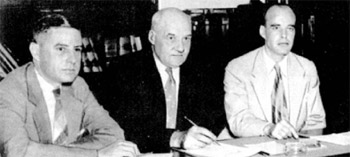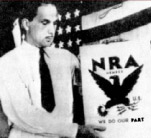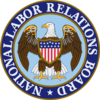1933 The NLB and "The Old NLRB"
The renewed interest in organizing, together with the refusal of many employers to recognize the unions their employees wanted, triggered strikes in support of the organizing drives. By August 1933, the situation had become so severe that President Franklin Roosevelt created a National Labor Board (NLB) to bring about compliance with Section 7(a) and to mediate labor disputes.
He made Senator Robert F. Wagner of New York its chairman. Three industry representatives were selected for the NLB by the National Recovery Administration's Industry Advisory Board, and three labor members were picked by the NRA's Labor Advisory Board. In early 1934, President Roosevelt authorized the NLB to conduct union representation elections and handle violations of the NIRA codes.
The NLB, however, lacked any real power. The authority of the National Recovery Administration, which administered the Act, was limited to withdrawing an employer's privilege of displaying the Blue Eagle, emblematic of NLRA participation. By  June 1934, when the NLB's authority expired, only four employers had been deprived of the Blue Eagle for violations of Section 7(a). Despite its problems in achieving voluntary compliance with Section 7(a), the NLB managed to settle 1,019 strikes, avert 498 others, and settle 1,800 other types of labor disputes.
June 1934, when the NLB's authority expired, only four employers had been deprived of the Blue Eagle for violations of Section 7(a). Despite its problems in achieving voluntary compliance with Section 7(a), the NLB managed to settle 1,019 strikes, avert 498 others, and settle 1,800 other types of labor disputes.
Frustrated by the NLB's failure to achieve voluntary compliance with Section 7(a), Senator Wagner introduced a bill in February 1934 to set up a permanent tripartite agency that would mediate labor disputes. The new board would be empowered to conduct representation elections and to prevent "unfair labor practices" by issuing cease-and-desist orders. The bill encouraged collective bargaining and prohibited employers from interfering with the right of employees to organize.
 Faced with mounting labor disputes, Congress in 1934 passed joint Public Resolution No. 44, authorizing the President to establish a new board as part of the NIRA. The board, called the National Labor Relations Board, would later be known as the "Old NLRB." Unlike the tripartite NLB, this "Old NLRB" was composed of three public members.
Faced with mounting labor disputes, Congress in 1934 passed joint Public Resolution No. 44, authorizing the President to establish a new board as part of the NIRA. The board, called the National Labor Relations Board, would later be known as the "Old NLRB." Unlike the tripartite NLB, this "Old NLRB" was composed of three public members.
The "Old NLRB" was powerless to enforce Section 7(a), just as the NLB had been, but it was able to achieve compliance from many cooperative employers in the public spirit of the era, which looked to the NIRA to restore the economy to better times. Its decisions also provided a foundation for an emerging national labor policy of collective bargaining.
The voluntary codes of the NIRA collapsed in May 1935, when the Supreme Court ruled that the NIRA was unconstitutional.
Photos (top to bottom): First meeting of the "Old NLRB" in July 1934. From left: Edwin S. Smith, Harry A. Millis, and Chairman Lloyd Garrison;Charles T. Coiner of Philadelphia Pa., displays NRA Eagle, the insignia he created, July 1933.


